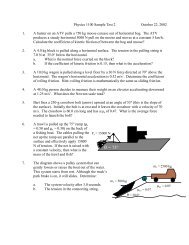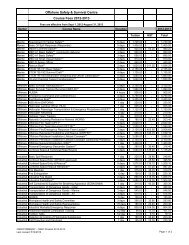Y:\How to solve 2 dimension relative velocity problems.wpd
Y:\How to solve 2 dimension relative velocity problems.wpd
Y:\How to solve 2 dimension relative velocity problems.wpd
You also want an ePaper? Increase the reach of your titles
YUMPU automatically turns print PDFs into web optimized ePapers that Google loves.
6. The math, with vec<strong>to</strong>r addition there are many options and these are classified by<br />
graphical and analytical means. In this tu<strong>to</strong>rial we will concentrate on the most efficient<br />
analytical means. When adding two vec<strong>to</strong>rs the Law of Sines and Cosines is probably<br />
best. However, the component method is easier <strong>to</strong> visualize. I will show both solutions<br />
for each problem.<br />
i. Practice 1: A large panel van has a <strong>velocity</strong> of<br />
30 m/s at 20° S of E in still air. A gust of<br />
wind of 20 m/s due East <strong>relative</strong> <strong>to</strong> the Earth<br />
strikes the van. What is the resultant <strong>velocity</strong><br />
of the van <strong>relative</strong> <strong>to</strong> the Earth, during the<br />
gust<br />
(1) Component method.<br />
Vec<strong>to</strong>r (v) and angle (2)<br />
X-comp<br />
v x = vcos2<br />
Y-comp<br />
v y = vsin2<br />
V va = 30 m/s, 20° V vax = 28.19 V vay = -10.26<br />
V vE = 20 m/s, 0° V vax = 20 V vEy = 0<br />
Resultant V vEx = 48.19 V vEy = -10.26<br />
Note using your diagram, YOU determine is a component is positive or negative.<br />
2 2 2 2<br />
vE vEx vEy<br />
v = v + v = 48.19 + ( − 10.26) = 49.3<br />
v −10.26<br />
θ = = = °<br />
v<br />
48.19<br />
−1 vEy −1<br />
tan ( ) tan ( ) 12.0 S of E<br />
vEx<br />
2 2<br />
vE<br />
=<br />
va<br />
+<br />
aE<br />
−<br />
va aE<br />
2 2<br />
30 20 2(30)(20)cos160 49.2<br />
m s<br />
m s<br />
v v v 2( v )( v )cosθ<br />
v<br />
vE<br />
= + − =<br />
−1 vaE<br />
sinθ<br />
−1<br />
20sin160<br />
β = sin ( ) = sin ( ) = 8.0°<br />
v<br />
49.2<br />
vE<br />
α = 20°− β = 12.0°<br />
(2) Law of sines and cosines
















